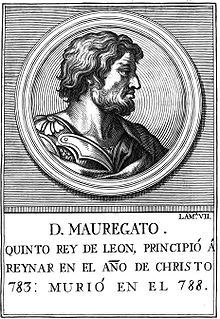
Alfonso II of Asturias, nicknamed the Chaste, was the king of Asturias during two different periods: first in the year 783 and later from 791 until his death in 842. Upon his death, Nepotian, a family member of undetermined relation, attempted to usurp the crown in place of the future Ramiro I.
The 780s decade ran from January 1, 780, to December 31, 789.

Year 783 (DCCLXXXIII) was a common year starting on Wednesday of the Julian calendar. The denomination 783 for this year has been used since the early medieval period, when the Anno Domini calendar era became the prevalent method in Europe for naming years.

Year 788 (DCCLXXXVIII) was a leap year starting on Tuesday of the Julian calendar. The denomination 788 for this year has been used since the early medieval period, when the Anno Domini calendar era became the prevalent method in Europe for naming years.

The Kingdom of Asturias was a kingdom in the Iberian Peninsula founded by the Visigothic nobleman Pelagius. It was the first Christian political entity established after the Umayyad conquest of Visigothic Hispania in 718. That year, Pelagius defeated an Umayyad army at the Battle of Covadonga, in what is usually regarded as the beginning of the Reconquista.
Alfonso I of Asturias, called the Catholic, was the third king of Asturias, reigning from 739 to his death in 757. His reign saw an extension of the Christian domain of Asturias, reconquering Galicia and León.
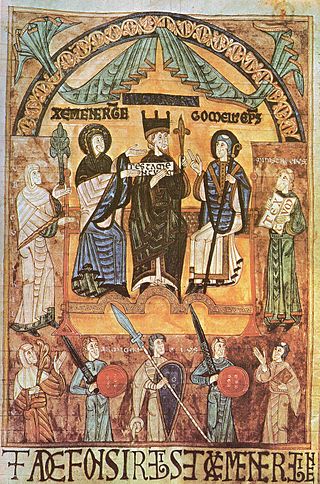
Alfonso III, called the Great, was the king of León, Galicia and Asturias from 866 until his death. He was the son and successor of Ordoño I. In later sources he is the earliest to be called "Emperor of Spain." He was also titled "Prince of all Galicia".

Fruela I, called the Cruel, was the King of Asturias from 757 until his death, when he was assassinated. He was the eldest son of Alfonso I and continued the work of his father. Pelayo was his maternal grandfather.
Aurelius was the King of Asturias from 768 to his death.
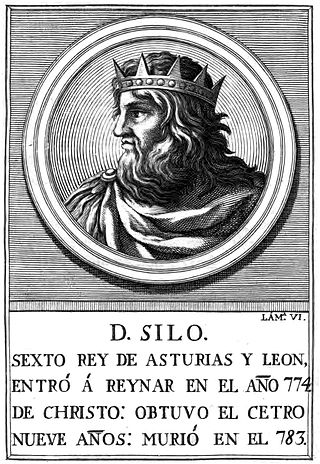
Silo was the king of Asturias from 774 to 783, succeeding Aurelius. He came to the throne upon his marriage to Adosinda, daughter of Alfonso I. He moved the capital of the Kingdom of Asturias from Cangas de Onís to Pravia, closer to the center of the kingdom. He was a contemporary of Abd al-Rahman I, Umayyad Emir of Córdoba, and of Charlemagne.
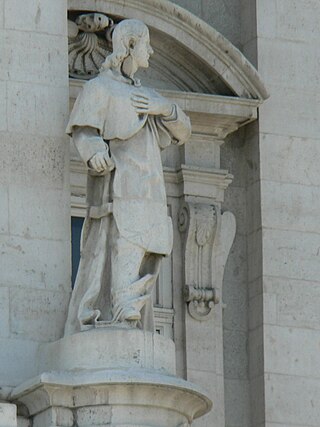
Bermudo I, called the Deacon or the Monk, was the King of Asturias from 788 or 789 until his abdication in 791. He was a son of Fruela of Cantabria, a nephew of Alfonso I, and a brother of Aurelius. The nature of the end of his reign ushered in a new period in Asturian-Arab relations.

Ramiro I was king of Asturias from 842 until his death in 850. Son of King Bermudo I, he became king following a succession struggle after his predecessor, Alfonso II, died without children. During his turbulent reign, he fended off attacks from both Vikings and Moors. Architecturally, his recreational palace Santa María del Naranco and other buildings used the ramirense style that prefigured Romanesque architecture. He was a contemporary of Abd ar-Rahman II, Umayyad Emir of Córdoba.

Simancas is a town and municipality of central Spain, located in the province of Valladolid, part of the autonomous community of Castile and León. It is situated approximately 10 km southwest of the provincial capital Valladolid, on the road to Zamora and the right bank of the river Pisuerga.
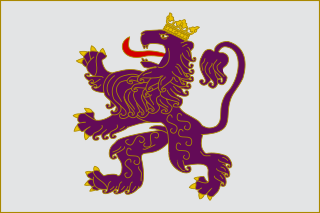
The Kingdom of León was an independent kingdom situated in the northwest region of the Iberian Peninsula. It was founded in 910 when the Christian princes of Asturias along the northern coast of the peninsula shifted their capital from Oviedo to the city of León. The kings of León fought civil wars, wars against neighbouring kingdoms, and campaigns to repel invasions by both the Moors and the Vikings, all in order to protect their kingdom's changing fortunes.
This is a historical timeline of Portugal.
This is a historical timeline of Portugal.
Adosinda was the queen of Asturias during the reign of her husband, Silo, from 774 to 783. She was a daughter of Alfonso I and Ermesinda, daughter of the first Asturian king, Pelayo. She was a sister of Fruela I.
The tribute of 100 virgins is a Spanish national myth as part of the Reconquista ideology. It rests on a legend narrative of annual tribute of one hundred virgin maidens paid by the Christian kingdom of Asturias to the Muslim emirate of Córdoba. The narrative also suggests that fifty were to be of noble birth and fifty commoners. The myth of tribute has been described "historically apocryphal but ideologically accurate" because it played important propaganda role in the formation and affirmation of the Reconquista ideology in the later Middle Ages, and it still figures prominently to this day in Spanish national cultural memory.
